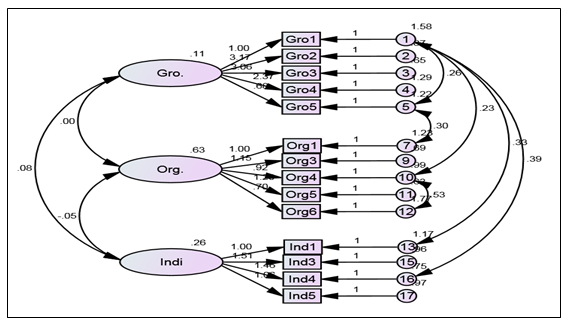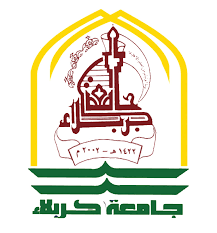The Intermediary Effect of Organizational Chaos in the Relationship between Organizational Conflict and Psychological Empowerment
Keywords:
Organizational Conflict, Organizational Chaos, Psychological Empowerment, University, Master Degree holders.Abstract
This study aims at determining the intermediary effect of organizational chaos in determining the quality of the relationship between organizational conflict and psychological empowerment. Due to the increasing cases of organizational conflict at Karbala University and the emergence of cases of chaos at many faculties, researchers have to conduct this study.
Methodology: The descriptive method was used to measure the study variables. The sample of the study included the Master and doctorate Degree holders in all the faculties of Karbala University. The sample was randomly selected. It included 332 of the study population (1711) . A number of statistical methods were used, such as measuring exploration factor and effect relationships between the variables of the study.
Findings: The study found that the organizational conflict affects the increasing of the organizational chaos with a small significant level. It was found, also, that the organizational chaos affect two dimensions of psychological empowerment. Moreover, there was a relationship between the organizational conflict and decreasing the psychological empowerment.
Organizational values: The studies, which considered the conflict and the organizational chaos, have not been applied to universities, however this sector suffers from conflicts at all levels, may be as a result of intense competition. When viewing previous researches, we did not notice the application of these three variables, which has a significant effect on the outputs of academic work.
Future researches can benefit from this study in studying each dimension of conflict, measuring its direct effect on the dimensions of psychological empowerment, as well as studying the positive effect of the conflict and the creative chaos.
References
Afzalur Rahim, M. (2002). Toward a theory of managing organizational conflict. International journal of conflict management, 13(3), 206-235.
http://www.emeraldinsight.com/doi/abs/10.1108/eb022874
Aldrich, H. (1971). Organizational boundaries and inter-organizational conflict. Human Relations. http://journals.sagepub.com/doi/abs/10.1177/001872677102400401?legid=sphum%3B24%2F4%2F279&patientinform-links=yes
Alkaya, S., & Yirik, Ş. (2014). Organizational cultures effects on organizational conflict: study of a five star hospitality business. Mediterranean Journal of Social Sciences, 5(22), 48. http://www.mcser.org/journal/index.php/mjss/article/view/4311
Ambad, S. N. A., & Bahron, A. (2012). Psychological empowerment: The influence on organizational commitment among employees in the construction sector. Journal of Global Business Management, 8(2), 73.
www.jgbm.org/page/9%20Arsiah%20Bahron.pdf
Andersen, G. R. (2006). Conflicts during organizational change: destructive or constructive?. Nordic Psychology, 58(3), 215.
http://psycnet.apa.org/journals/nop/58/3/215/
Andrade, J., Mendes, L., & Lourenço, L. (2015). Perceived psychological empowerment and total quality management-based quality management systems: an exploratory research. Total Quality Management & Business Excellence, 1-12. http://www.tandfonline.com/doi/abs/10.1080/14783363.2015.1050166
Arciniega, L. M., & Menon, S. T. (2013). The power of goal internalization: studying psychological empowerment in a Venezuelan plant. The International Journal of Human Resource Management, 24(15), 2948-2967.
http://www.tandfonline.com/doi/abs/10.1080/09585192.2013.763846
Barroso Castro, C., Villegas Perinan, M. M., & Casillas Bueno, J. C. (2008). Transformational leadership and followers' attitudes: The mediating role of psychological empowerment. The International Journal of Human Resource Management, 19(10), 1842-1863.
http://www.tandfonline.com/doi/abs/10.1080/09585190802324601
Bartram, T., Karimi, L., Leggat, S. G., & Stanton, P. (2014). Social identification: linking high performance work systems, psychological empowerment and patient care. The International Journal of Human Resource Management, 25(17), 2401-2419. http://www.tandfonline.com/doi/abs/10.1080/09585192.2014.880152
Beham, B. (2011). Work–family conflict and organisational citizenship behaviour: empirical evidence from Spanish employees. Community, Work & Family, 14(1), 63-80. http://www.tandfonline.com/doi/abs/10.1080/13668803.2010.506034
Bélanger, J. J., Pierro, A., Barbieri, B., De Carlo, N. A., Falco, A., & Kruglanski, A. W. (2015). Handling conflict at work: The role of fit between subordinates’ need for closure and supervisors’ power tactics. International Journal of Conflict Management, 26(1), 25-43. http://www.emeraldinsight.com/doi/abs/10.1108/IJCMA-09-2013-0083
Bhatnagar, J. (2005). The power of psychological empowerment as an antecedent to organizational commitment in Indian managers. Human Resource Development International, 8(4), 419-433.
http://www.tandfonline.com/doi/abs/10.1080/13678860500356101
Bhatnagar, J. (2007). Predictors of organizational commitment in India: strategic HR roles, organizational learning capability and psychological empowerment. The International Journal of Human Resource Management, 18(10), 1782-1811.
http://www.emeraldinsight.com/doi/abs/10.1108/hrmid.2008.04416cad.003
Bhatnagar, J. (2012). Management of innovation: Role of psychological empowerment, work engagement and turnover intention in the Indian context. The International Journal of Human Resource Management, 23(5), 928-951.
http://www.tandfonline.com/doi/abs/10.1080/09585192.2012.651313?journalCode=rijh20
Bigdon, C., & Korf, B. (2004). The role of development aid in conflict transformation: Facilitating empowerment processes and community building. In Transforming Ethnopolitical Conflict (pp. 341-370). VS Verlag für Sozialwissenschaften.
https://link.springer.com/chapter/10.1007%2F978-3-663-05642-3_17
Bodtker, A. M., & Katz Jameson, J. (2001). Emotion in conflict formation and its transformation: Application to organizational conflict management. International Journal of Conflict Management, 12(3), 259-275.
www.emeraldinsight.com/doi/abs/10.1108/eb022858
Bowen, D. E., & Lawler III, E. E. (2006). The empowerment of service workers: What, why, how, and when. Managing innovation and change, 155-69.
Bruk-Lee, V., Nixon, A. E., & Spector, P. E. (2013). An expanded typology of conflict at work: Task, relationship and non-task organizational conflict as social stressors. Work & Stress, 27(4), 339-350.
http://www.tandfonline.com/doi/abs/10.1080/02678373.2013.841303
Brunetto, Y., Shacklock, K., Bartram, T., Leggat, S. G., Farr-Wharton, R., Stanton, P., & Casimir, G. (2012). Comparing the impact of leader–member exchange, psychological empowerment and affective commitment upon Australian public and private sector nurses: implications for retention. The International Journal of Human Resource Management, 23(11), 2238-2255.
http://www.tandfonline.com/doi/abs/10.1080/09585192.2011.616524
Cropanzano, R., & Baron, R. A. (1991). Injustice and organizational conflict: The moderating effect of power restoration. International Journal of Conflict Management, 2(1), 5-26. http://www.emeraldinsight.com/doi/abs/10.1108/eb022691
Cummins, R. A. (1996). The domains of life satisfaction: An attempt to order chaos. Social indicators research, 38(3), 303-328.
https://www.jstor.org/stable/27522935
De Villiers, J. R., & Stander, M. W. (2011). Psychological empowerment, work engagement and turnover intention: The role of leader relations and role clarity in a financial institution. Journal of Psychology in Africa, 21(3), 405-412. www.tandfonline.com/doi/pdf/10.1080/14330237.2011.10820474
Di Virgilio, F., & Di Pietro, L. (2011). Organizational conflict: A critical approach on formal and informal management processes. Available at SSRN 1927855. https://papers.ssrn.com/sol3/papers.cfm?abstract_id=1927855
Ekstrand, L. H., & Ray, R. (2001). Chaos and complexity in development. The International Journal of Sustainable Development & World Ecology, 8(2), 127-136. http://www.tandfonline.com/doi/abs/10.1080/13504500109470070
Elmes, M. B., & Taylor, S. S. (2005, August). From chaos to tempered radicalism: the form and content of organizational resistance. In Academy of Management Proceedings (Vol. 2005, No. 1, pp. C1-C6). Academy of Management.
http://proceedings.aom.org/content/2005/1/C1.17.short
Euwema, M. C., Van de Vliert, E., & Bakker, A. B. (2003). Substantive and relational effectiveness of organizational conflict behavior. International Journal of Conflict Management, 14(2), 119-139.
http://www.emeraldinsight.com/doi/abs/10.1108/eb022894
Farooqi, M., Khan, H. M. A., & Arshad, F. (2014). Development and Validation of Farooqi Organizational Conflict Inventory (FOCI). PUTAJ - Humanities and Social Sciences, Vol. 21, No.2, 189-201.
http://putaj.org/index.php/humanities/issue/view/41/showToc
Fitzgerald, L. A. (2002). Chaos: the lens that transcends. Journal of Organizational Change Management, 15(4), 339-358.
www.emeraldinsight.com/doi/pdf/10.1108/09534810210433665
Fitzgerald, L. A., & van Eijnatten, F. M. (2002). Chaos speak a glossary of chaordic terms and phrases. Journal of Organizational Change Management, 15(4), 412-423. www.emeraldinsight.com/doi/abs/10.1108/09534810210433719
Fitzgerald, L. A., & van Eijnatten, F. M. (2002). Reflections: Chaos in organizational change. Journal of Organizational Change Management, 15(4), 402-411. www.emeraldinsight.com/doi/pdf/10.1108/09534810210433700
Forenza, B. (2016). Psychological Empowerment and the Pursuit of Social Change: Outcomes of Foster Youth Engagement. Journal of Public Child Welfare, 10(3) 1-17. http://www.tandfonline.com/doi/abs/10.1080/15548732.2016.1140698
Gelfand, M. J., Leslie, L. M., & Keller, K. M. (2008). On the etiology of conflict cultures. Research in Organizational Behavior, 28, 137-166.
http://www.sciencedirect.com/science/article/pii/S0191308508000099
George, R. T., & Hancer, M. (2004). The impact of selected organizational factors on psychological empowerment of non-supervisory employees in full-service restaurants. Journal of Foodservice Business Research, 6(2), 35-47.
www.tandfonline.com/doi/abs/10.1300/J369v06n02_04
Gkorezis, P., & Petridou, E. (2012). The effect of extrinsic rewards on public and private sector employees' psychological empowerment: a comparative approach. The International Journal of Human Resource Management, 23(17), 3596-3612. http://www.tandfonline.com/doi/abs/10.1080/09585192.2011.639025?src=recsys&journalCode=rijh20
Grey, C., & Sturdy, A. (2010). A Chaos that Worked Organizing Bletchley Park. Public Policy and Administration, 25(1), 47-66.
http://journals.sagepub.com/doi/abs/10.1177/0952076709347075
Groom, A. J. R., & Webb, K. (1987). Injustice, empowerment, and facilitation in conflict. International Interactions, 13(3), 263-280.
www.tandfonline.com/doi/abs/10.1080/03050628708434678
Hardy, J. (1999). Chaos in environmental education. Environmental Education Research, 5(2), 125-142. www.tandfonline.com/doi/abs/10.1080/1350462990050201
Hasani, K., Boroujerdi, S. S., Sheikhesmaeili, S., & Aeini, T. (2014). Identity of organizational conflict framework: Evaluating model factors based on demographic characteristics in Iran. Journal of Industrial Engineering and Management, 7(5), 1013. http://www.jiem.org/index.php/jiem/article/view/1061
Hasse, G. W., & Bekker, M. C. (2016). Chaos attractors as an alignment mechanism between projects and organizational strategy. Procedia-Social and Behavioral Sciences, 226, 91-99. www.sciencedirect.com/science/article/pii/S1877042816308527
Hodson, R., Roscigno, V. J., & Lopez, S. H. (2006). Chaos and the Abuse of Power Workplace Bullying in Organizational and Interactional Context. Work and occupations, 33(4), 382-416.
http://journals.sagepub.com/doi/abs/10.1177/0730888406292885
Hodson, R., Roscigno, V. J., & Lopez, S. H. (2006). Chaos and the abuse of power workplace bullying in Organizational and interactional context. Work and occupations, 33(4), 382-416.
http://journals.sagepub.com/doi/abs/10.1177/0730888406292885
Hoogerwerf, E. C., & Poorthuis, A. M. (2002). The network multilogue: a chaos approach to organizational design. Journal of Organizational Change Management, 15(4), 382-390.
www.emeraldinsight.com/doi/abs/10.1108/09534810210433683
Houry, S. A. (2012). Chaos and organizational emergence: towards short term predictive modeling to navigate a way out of chaos. Systems Engineering Procedia, 3, 229-239. www.sciencedirect.com/science/article/pii/S2211381911001780
Humborstad, S. I. W., & Dysvik, A. (2016). Organizational tenure and mastery-avoidance goals: the moderating role of psychological empowerment. The International Journal of Human Resource Management, 27(12), 1237-1251.
www.tandfonline.com/doi/full/10.1080/09585192.2015.1061579
Irvin, L. (2002). Ethics in organizations: A chaos perspective. Journal of Organizational Change Management, 15(4), 359-381.
www.emeraldinsight.com/doi/abs/10.1108/09534810210433674
Janssen*, O. (2004). The barrier effect of conflict with superiors in the relationship between employee empowerment and organizational commitment. Work & Stress, 18(1), 56-65. www.tandfonline.com/doi/abs/10.1080/02678370410001690466
Javed, B., Khan, A. A., Bashir, S., & Arjoon, S. (2016). Impact of ethical leadership on creativity: the role of psychological empowerment. Current Issues in Tourism, 1-13. http://www.tandfonline.com/doi/abs/10.1080/13683500.2016.1188894?journalCode=rcit20
Johnson, P. E., & Short, P. M. (1998). Principal's leader power, teacher empowerment, teacher compliance and conflict. Educational Management & Administration, 26(2), 147-159. http://journals.sagepub.com/doi/abs/10.1177/0263211X98262004
Joo, B. K., & Shim, J. H. (2010). Psychological empowerment and organizational commitment: the moderating effect of organizational learning culture. Human Resource Development International, 13(4), 425-441.
www.tandfonline.com/doi/abs/10.1080/13678868.2010.501963
Jose, G., & Mampilly, S. R. (2015). Relationships among Perceived Supervisor Support, Psychological Empowerment and Employee Engagement in Indian Workplaces. Journal of Workplace Behavioral Health, 30(3), 231-250.
www.tandfonline.com/doi/full/10.1080/15555240.2015.1047498
Kilburg, R. R. (2000). Executive coaching: Developing managerial wisdom in a world of chaos. American Psychological Association.
http://www.apa.org/pubs/books/431744A.aspx
Kostiwa, I. M., & Meeks, S. (2009). The relation between psychological empowerment, service quality, and job satisfaction among certified nursing assistants. Clinical Gerontologist, 32(3), 276-292.
www.tandfonline.com/doi/abs/10.1080/07317110902895309
Kreutzer, K., & Jäger, U. (2011). Volunteering versus managerialism: Conflict over organizational identity in voluntary associations. Nonprofit and Voluntary Sector Quarterly, 40(4), 634-661.
http://journals.sagepub.com/doi/abs/10.1177/0899764010369386
Lambert, E. G., Kelley, T., & Hogan, N. L. (2013). Work-family conflict and organizational citizenship behaviors. Journal of Crime and Justice, 36(3), 398-417.
www.tandfonline.com/doi/abs/10.1080/0735648X.2012.706402
Laslo, Z., & Goldberg, A. I. (2008). Resource allocation under uncertainty in a multi-project matrix environment: Is organizational conflict inevitable?. International Journal of Project Management, 26(8), 773-788.
Lee, J., & Wei, F. (2011). The mediating effect of psychological empowerment on the relationship between participative goal setting and team outcomes–a study in China. The International Journal of Human Resource Management, 22(02), 279-295.
www.tandfonline.com/doi/abs/10.1080/09585192.2011.540152
Levy, D. (1994). Chaos theory and strategy: Theory, application and managerial implications. Strategic management journal, 15, 167-167.
http://onlinelibrary.wiley.com/doi/10.1002/smj.4250151011/abstract
Lin, C. P., Lin, M. Z., & Li, Y. B. (2015). An empirical study on the effect of paternalistic leadership on employees’ voice behaviors–the intermediary role of psychological empowerment. Journal of Interdisciplinary Mathematics, 18(6), 789-810. www.tandfonline.com/doi/abs/10.1080/09720502.2015.1108089
Macsinga, I., Sulea, C., Sârbescu, P., Fischmann, G., & Dumitru, C. (2015). Engaged, committed and helpful employees: the role of psychological empowerment. The Journal of psychology, 149(3), 263-276.
www.tandfonline.com/doi/abs/10.1080/00223980.2013.87432
Martínez-Pecino, R., Munduate, L., & Medina, F. J. (2008). Organizational conflict management by out-of-court means . Papeles del Psicólogo, 29(1), 41-48.
McBride, N. (2005). Chaos theory as a model for interpreting information systems in organizations. Information Systems Journal, 15(3), 233-254.
http://onlinelibrary.wiley.com/doi/10.1111/j.1365-2575.2005.00192.x/abstract
Mo, S., Booth, S. A., & Wang, Z. (2012). How do Chinese firms deal with inter-organizational conflict?. Journal of business ethics, 108(1), 121-129.
https://link.springer.com/article/10.1007/s10551-011-1066-8
Munoz-Flores, H., Munduate Jaca, L., Medina, F. J., & Guerra, J. (2007). Copying with Bullying as an Intractable Organizational Conflict. In IACM 2007 Meetings Paper. https://papers.ssrn.com/sol3/papers.cfm?abstract_id=1111625
Nonaka, I. (1988). Creating organizational order out of chaos: Self-renewal in Japanese firms. California management review, 30(3), 57-73.
http://journals.sagepub.com/doi/abs/10.2307/41166514
Numagami, T., Karube, M., & Kato, T. (2010). Organizational deadweight: learning from Japan. The Academy of Management Perspectives, 24(4), 25-37.
http://amp.aom.org/content/24/4/25.abstract
Olekalns, M. (1997). Conflict at work: Defining and resolving organisational conflicts. Australian Psychologist, 32(1), 56-61.
http://onlinelibrary.wiley.com/doi/10.1080/00050069708259618/full
Ouyang, Y. Q., Zhou, W. B., & Qu, H. (2015). The impact of psychological empowerment and organisational commitment on Chinese nurses’ job satisfaction. Contemporary nurse, 50(1), 80-91.
www.tandfonline.com/doi/abs/10.1080/10376178.2015.1010253
Peake, S., & McDowall, A. (2012). Chaotic careers: a narrative analysis of career transition themes and outcomes using chaos theory as a guiding metaphor. British Journal of Guidance & Counselling, 40(4), 395-410.
www.tandfonline.com/doi/abs/10.1080/03069885.2012.704350
Peterson, N. A., & Speer, P. W. (2000). Linking organizational characteristics to psychological empowerment: Contextual issues in empowerment theory. Administration in Social Work, 24(4), 39-58. www.tandfonline.com/doi/abs/10.1300/J147v24n04_03
Plocharczyk, L. (2007). On organizational conflict: Reaping the benefits of effective conflict management. Journal of access services, 4(1-2), 85-120.
www.tandfonline.com/doi/abs/10.1300/J204v04n01_06
Pondy, L. R. (1967). Organizational conflict: Concepts and models. Administrative science quarterly, 296-320. https://www.jstor.org/stable/2391553
Quinn, R. E., & Spreitzer, G. M. (1997). The road to empowerment: Seven questions every leader should consider. organizational Dynamics, 26(2), 37-49.
http://www.sciencedirect.com/science/article/pii/S0090261697900048
Radu, B. Ş., Liviu, M., & Cristian, G. (2014). Aspects Regarding the Positive and Negative Sides of Chaos Applied to the Management Science in Projects of Organizational Change. Procedia Economics and Finance, 15, 1543-1548.
www.sciencedirect.com/science/article/pii/S2212567114006236
Rahim, M. A. (1983). Measurement of organizational conflict. The Journal of General Psychology, 109(2), 189-199.
www.tandfonline.com/doi/abs/10.1080/00221309.1983.10736085
Roscigno, V. J., Hodson, R., & Lopez, S. H. (2009). Workplace incivilities: the role of interest conflicts, social closure and organizational chaos. Work, Employment & Society, 23(4), 747-773.
http://journals.sagepub.com/doi/abs/10.1177/0950017009344875
Short, P. M., & Johnson, P. E. (1994). Exploring the Links among Teacher Empowerment, Leader Power, and Conflict. https://eric.ed.gov/?id=ED372044
Siira, K. (2012). Conceptualizing Managerial Influence in Organizational Conflict—A Qualitative Examination. Negotiation and Conflict Management Research, 5(2), 182-209. http://onlinelibrary.wiley.com/doi/10.1111/j.1750-4716.2012.00096.x/abstract
Smits, S. J., Falconer, J. A., Morland, R., & Strasser, D. C. (2015). The organizational context for medical rehabilitation services: a pre-chaos theory perspective. Topics in Stroke Rehabilitation. http://www.tandfonline.com/doi/abs/10.1310/DH1K-GJQW-G481-4LD1?tab=permissions&scroll=top
Spreitzer, G. M. (1995). Psychological empowerment in the workplace: Dimensions, measurement, and validation. Academy of management Journal, 38(5), 1442-1465.
http://amj.aom.org/content/38/5/1442
Susskind, A. M., Miller, V. D., & Johnson, J. D. (1998). Downsizing and Structural Holes Their Impact on Layoff Survivors' Perceptions of Organizational Chaos and Openness to Change. Communication Research, 25(1), 30-65.
http://journals.sagepub.com/doi/abs/10.1177/009365098025001002
Sweeney, P. (2007). Organizational chaos and relative powerlessness: Breeding ground for bullies?. The Academy of Management Perspectives, 21(2), 77-78.
http://amp.aom.org/content/21/2/77.abstract
Tsoukas, H. (1998). Introduction: chaos, complexity and organization theory. Organization, 5(3), 291-313.
http://journals.sagepub.com/doi/abs/10.1177/135050849853001
Üstüner, M., & Kis, A. (2014). The Relationship between Communication Competence and Organizational Conflict: A Study on Heads of Educational Supervisors. Eurasian Journal of Educational Research, 56, 23-44. https://eric.ed.gov/?id=EJ1060475
Van den Berg, S. W., Van Amstel, F. K. P., Ottevanger, P. B., Gielissen, M. F., & Prins, J. B. (2013). The cancer empowerment questionnaire: Psychological empowerment in breast cancer survivors. Journal of psychosocial oncology, 31(5), 565-583.
http://www.tandfonline.com/doi/abs/10.1080/07347332.2013.825361?src=recsys&journalCode=wjpo20
Van Dop, N., Depauw, J., & Driessens, K. (2016). Measuring Empowerment: Development and Validation of the Service User Psychological Empowerment Scale. Journal of Social Service Research, 42(5), 651-664.
www.tandfonline.com/doi/abs/10.1080/01488376.2016.1216915
Van Eijnatten, F. M., & van Galen, M. (2002). Chaos, dialogue and the dolphin's strategy. Journal of Organizational Change Management, 15(4), 391-401.
www.emeraldinsight.com/doi/pdf/10.1108/09534810210433692
Vanacken, D., Raymaekers, C., Luyten, K., & Coninx, K. (2007, July). Focus+ Roles: socio-organizational conflict resolution in collaborative user interfaces. In International Conference on Human-Computer Interaction (pp. 788-796). Springer Berlin Heidelberg. https://link.springer.com/chapter/10.1007%2F978-3-540-73111-5_88
Wallin, D. L., & Ryan, J. R. (1994). Order out of chaos: Leadership for the 21st century. Community College Journal of Research and Practice, 18(6), 527-538.
www.tandfonline.com/doi/abs/10.1080/1066892940180602
Warschauer, M., Turbee, L., & Roberts, B. (1996). Computer learning networks and student empowerment. System, 24(1), 1-14. https://eric.ed.gov/?id=EJ527752
Whitaker, B. G., & Westerman, J. W. (2014). Linking spirituality and values to personal initiative through psychological empowerment. Journal of Management, Spirituality & Religion, 11(3), 269-291.
www.tandfonline.com/doi/abs/10.1080/14766086.2014.90522
Yen, C. D., Yeh, C. H., & Lin, S. Y. (2016). Psychological empowerment and service orientation: A study of front-line employees in the food and beverage industry. Journal of Foodservice Business Research, 19(3), 298-314.
www.tandfonline.com/doi/abs/10.1080/15378020.2016.1178047

Downloads
Published
How to Cite
Issue
Section
License
Copyright (c) 2017 Economics and Administration College - Karbala University

This work is licensed under a Creative Commons Attribution-NonCommercial-NoDerivatives 4.0 International License.
Authors retain the copyright of their papers without restrictions.









